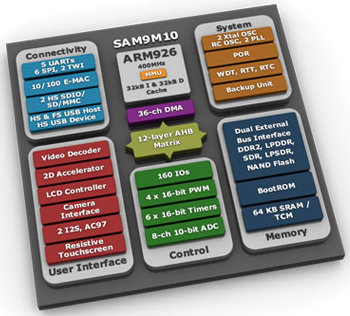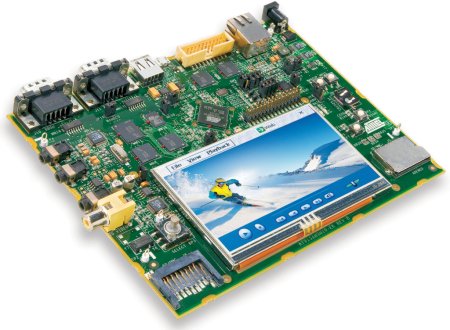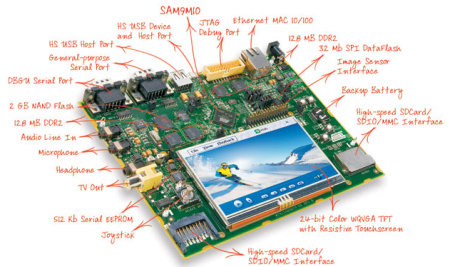ARM9 SoCs get hardware encryption
Apr 26, 2010 — by LinuxDevices Staff — from the LinuxDevices Archive — 5 viewsAtmel is using this week's ESC (Embedded Systems Conference) in Silicon Valley to launch two ARM-based system-on-chips (SoCs) featuring hardware encryption and authentication. The SAM9G46 and SAM9M11 support 256-bit AES, triple DES, and SHA, and they'll run Linux on 400MHz ARM929EJ cores, the company says.
Atmel's announcement of the SAM9G46 and SAM9M11 has not yet been accompanied by block diagrams, but the company says the new SoCs are "direct derivatives" of its earlier SAM9G45 and SAM9M10, announced in July 2009 and January 2010, respectively. Including the SAM9G46 and SAM9M11, Atmel now offers a total of 11 Linux-ready SAM9 microprocessors.
Apparently pin-compatible with their predecessors, and using the same BGA324 package, the SAM9G46 and SAM9M11 differ in just one key respect: Both are said to have on-chip authentication and encryption capabilities. Atmel says both SoCs support 256-bit AES, triple DES, and SHA, making them "tailored for industrial embedded systems that require secured connectivity and authentication of applications."
Like the original SAM9G45, the SAM9G46 and SAM9M11 are built around a 400MHz ARM926EJ core. Twin parallel external bus interfaces (EBI) support DDR2 memory at 133MHz, while high-speed (480Mbps) USB host and device ports are supported with on-chip transceivers, says Atmel.
The new SoCs also share the SAM9G45's Ethernet MAC, high-speed SD/SDIO/MMC interfaces, and an LCD controller with resistive touchscreen support. Like the SAM9G45, they offer CMOS camera and audio interfaces, as well as support for either 1.8 or 3.3 Volt I/O supply voltage, Atmel adds.
The SAM9M10 built on the SAM9G45's base by adding a video decoder, said to decode video streams at up to D1 (720 x 576), or WVGA (800 x 480) at 30 frames per second (fps). Supporting H264, H263, MPEG4, MPEG2, VC1, and JPEG formats, the SAM9M10 also includes 2D graphics acceleration, image scaling and image rotation, color space conversion (YUV to RGB), and picture-in-picture capability, according to Atmel.
The new SAM9M11 is similar, inheriting all of the SAM9M10's video chops and adding hardware encryption capabilities. As such, it becomes Atmel's top-of-the-line ARM9 offering.
A "data speedway"
When it announced the SAM910 in January, Atmel said the SoC's 12-layer system bus matrix is linked to the Memory Management Unit (MMU) of the processor core and to the following:
- eight central DMA channels
- six high-speed DMAs, each dedicated to the video decoder
- 21 Peripheral DMA (PDC) channels
- dual EBI
- small blocks of on-chip distributed SRAM
- and the aforementioned LCD, USB, Ethernet, and imaging peripherals
As a result of this "high data speedway" architecture, the SAM9M10 can perform 100Mbps+ data transfers, video decoding, and UI rendering in parallel with computationally intensive data processing, claims the company.

SAM9M10 architecture
Running at 400MHz with a 1.0V core supply, power consumption is typically less than 300uW/MHz, claims Atmel, and in backup mode with the RTC running, the SAM9M10 is said to consume about 8 uA. Its system controller incorporates startup, shutdown, and power-on reset controllers, as well as on-chip oscillators for 12MHz and 32KHz, and a power management controller (PMC).
Evaluation kits
As we noted earlier in this story, Atmel has not yet released block diagrams for the SAM9G46 and SAM9M11, nor has it provided word of any relevant hardware/software evaluation kits. (More info will probably appear after the SoCs' formal unveiling at ESC.)
We expect the company to offer kits for the SAM9G46 and SAM9M11 that are very similar to those for the earlier SAM9 SoCs, including Linux and Windows CE BSPs (board support packages). After all, in January Atmel announced a SAM9M10-EK kit that appeared to be identical to its earlier SAM9G45-EK board except for the inclusion of the newer SoC.
The SAM9M10-EK, pictured below, offers two banks of 128MB DDR2 memory, each connected to an external bus interface, as well as 2GB of NAND, and 32MB (2M x 16) of flash memory dedicated to storing application data or firmware uploaded into DDR2 memory at system boot. Dual high-speed SD/SDIO/MMC slots are also said to be supplied.

SAM9M10-EK evaluation board
(Click to enlarge)

SAM9M10-EK (detail)
(Click to enlarge)
Availability
Atmel has not yet released pricing or availability for the SAM9G46 or SAM9M11. A February 2010 document citing the SoCs and listing them as "under development" may be found on the company's website, here [PDF link].
Further information on the existing SAM9G45 and SAM9M10 may be found on Atmel's website, here.
This article was originally published on LinuxDevices.com and has been donated to the open source community by QuinStreet Inc. Please visit LinuxToday.com for up-to-date news and articles about Linux and open source.